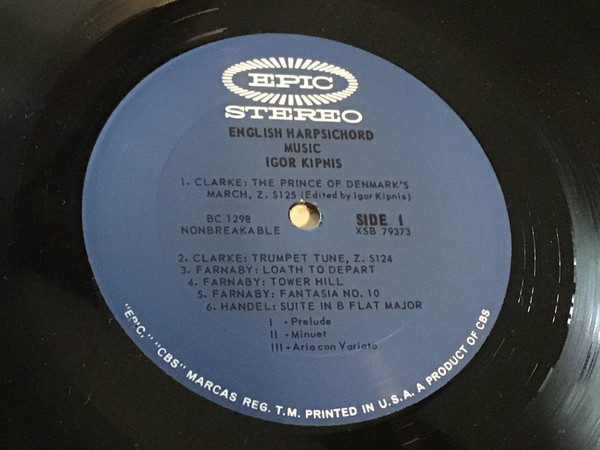MusiQ
Igor Kipnis - English Harpsichord Music
Table of Contents
Download
Filename: igor-kipnis-english-harpsichord-music.rar- MP3 size: 76.8 mb
- FLAC size: 710.4 mb
Tracks
| Track | Duration | Preview |
|---|---|---|
| Pavana, The Earl Of Salisbury (Panthenia No. 6) | ||
| Suite In B-Flat Major (Book 2, No. 1): 1. Prelude, 2. Minuet, 3. Aria Con Variato | ||
| Fantasia No. 10 (F.V.B. No. 129) | ||
| Galiardo (Panthenia No. 7) | ||
| Wolsey's Wilde (F.V.B. No. 157) | ||
| The Queen's Alman (F.V.B. No. 172) | ||
| Aire In D Minor, Z. T675 | ||
| Queen Elizabeth's Pavin | ||
| Loath To Depart (Fitzwilliam Virginal Book No. 230) | ||
| The Prince Of Denmark's March, Zimmerman S125 | ||
| Tower Hill (F.V.B. No. 245) | ||
| The Prince's Galliard | ||
| Suite In C Major (From Musick's Hand Maid, Part 2), Z. T665 -1. Prelude, 2. Almond, 3. Corant, 4. Saraband, 5. Jigg | ||
| Round O (Rondo), Z. T684 | ||
| A Gigg (F.V.B. No. 181) | ||
| Trumpet Tune, Zimmerman S124 |
Video
Igor Kipnis (harpsichord) English Harpsichord Music
Images


Catalog Numbers
BC1298Labels
EpicListen online
- escuchar en línea
- online anhören
- lyssna på nätet
- kuunnella verkossa
- écouter en ligne
- online luisteren
- lytte på nettet
- ouvir online
- ascolta in linea
Formats
- Vinyl
- LP
- Album
- Stereo
Notes
Library of Congress catalogue # R65-2235About Igor Kipnis
American harpsichordist and pianist (27 September 1930 - 23 January 2002), he was the son of the operatic bass vocalist .
He designed the jacket of Westminster Gold series, which is famous for the weird design, under the pseudonym of .
Name Vars
- I. Kipnis
- ¤´üëû×˹


William Byrd (1543-1623), a great favourite of
Queen Elizabeth and a member of her Chapel
Royal, was known as '''a father of Musick" even
in his own day, He was a pioneer of style in
virginal music, who combined the popular a.nd
. practical interest in dance music and songs with
virtuoso ornamentation and harmonic elaboration,
" Wolsey's Wilde" (called variously "Wilson's
Tune" or "Wilson's Wile") was a favourite
ballad of the epoch. The "Pavana, the Earl of
Salisbury" was presumably composed for the
wake of the Earl himself, Robert Cecil, in 1612.
Both the "Pavana" and the "Galiardo
In spite of the interruption in England's
development of the arts caused by the Puritanical
Commonwealth, the restored monarchy
proved to be as generous a patron of music as the
Tudors and Jacobeans. Henry Purcell (c. 1659-
1695) began his career as a chorister of the
Chapel Royal .and was appointed organist there
in 1682, having earlier held a similar position at '
WestIninster Abbey. His harpsichord music is in
a lighter vein, much of it having been composed
for teaching purposes. The "Suit of Lessons" in
C major first appeared in The Second Part of
Musick 's Hand Maid , the only collection published
in his lifetime that included Purcell's
keyboard music. Save for the opening Prelude,
the movements are all dances: Almond (A1man),
Corant, Saraband and Jigg. The " Round 0" (Le.
Rondo), in D minor-familiar from its use by
Benjamin Britten as the theme of his "Young
Person's Guide to the Orchestra"-is actually a
harpsichord transcription by Purcell of a Rondeau
for strings from his incidental music to
the play, by Mrs. Aphra Behn, Abdelazer, or the
Moor's Revenge. Purcell also transcribed the
" Aire in D minor" from a piece for strings included
in the opera The Indian Queen.
Jeremiah Clarke (c. 1673-1707) was a contemporary
of Purcell, a talented man who in a fit of
melancholy shot himself at the age of thirtyfour.
Much of his music has been mistakenly
attributed to Purcell, including both of the
pieces performed here. The " Trumpet Tune" ,
representative of a very popular genre in the
late seventeenth century, is usually heard
flanking Purcell's "Aire in D minor" as the
" Trumpet Tune and Air". Clarke's "The Prince
of Denmark's March" has been known for so long
as "Purcell's Trumpet Voluntary" that it is
doubtful whether the association can ever be
erased from public memory.
Another inveterate composer of "Lessons"
for the harpsichord was Georg Frideric Handel
(1685-1759), instructor to the Prmcesses Anne
and Caroline, daUghters of George n. The three
pieces, entitled Prelude, Aria con Variato and
Minuet, were first published in 1727 under the
composer's direction as part of the second book
of his keyboard suites. The music was pirated by
the publisher John Walsh in 1733, in which
edition the trio of pieces was collected under
the name "Lesson No. 1 in B flat major". In Mr.
Kipnis' recorded performance, the Minuet has
been placed as the second movement. The Aria
is the one used by Brahms as the basis for his
"Variations and Fugue on a Theme of Handel
Igor Kipnis
"A harpsichordist of the first rank."
-American Record Guide.
The young American harpsichordist Igor
Kipn is (his father is the , famous basso.
Alexander Kipnis) has appeared in concerts
and lecture-recitals throughout the United
States. and has been a music reviewer for.
among other papers. the New York, Herald
Tribune. He is currently Chairman of the
Baroque Department at the Berkshire Music
Center at Tanglewood, where he gives
instru ction in harpsichord and Baroque
stylistic practices. In line with his researches
in the latter field. the embellishments used on
this record were improvised by Mr. Kipnis in
performance.
Mr. Kipnis' harpsichord was built for him in
New York in 1961 by Rutkowski and
Robinette. It has the following specification :
Lower Manual-8 leather (Peau de buffle) .
8 quills. 4 quills. harp (buff stop) on both 8s :
Upper Manual-8 quills ; Manual coupler